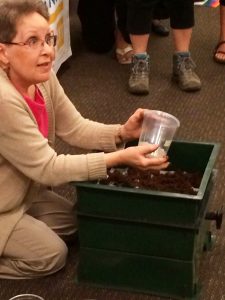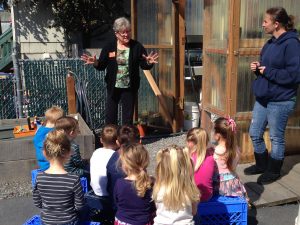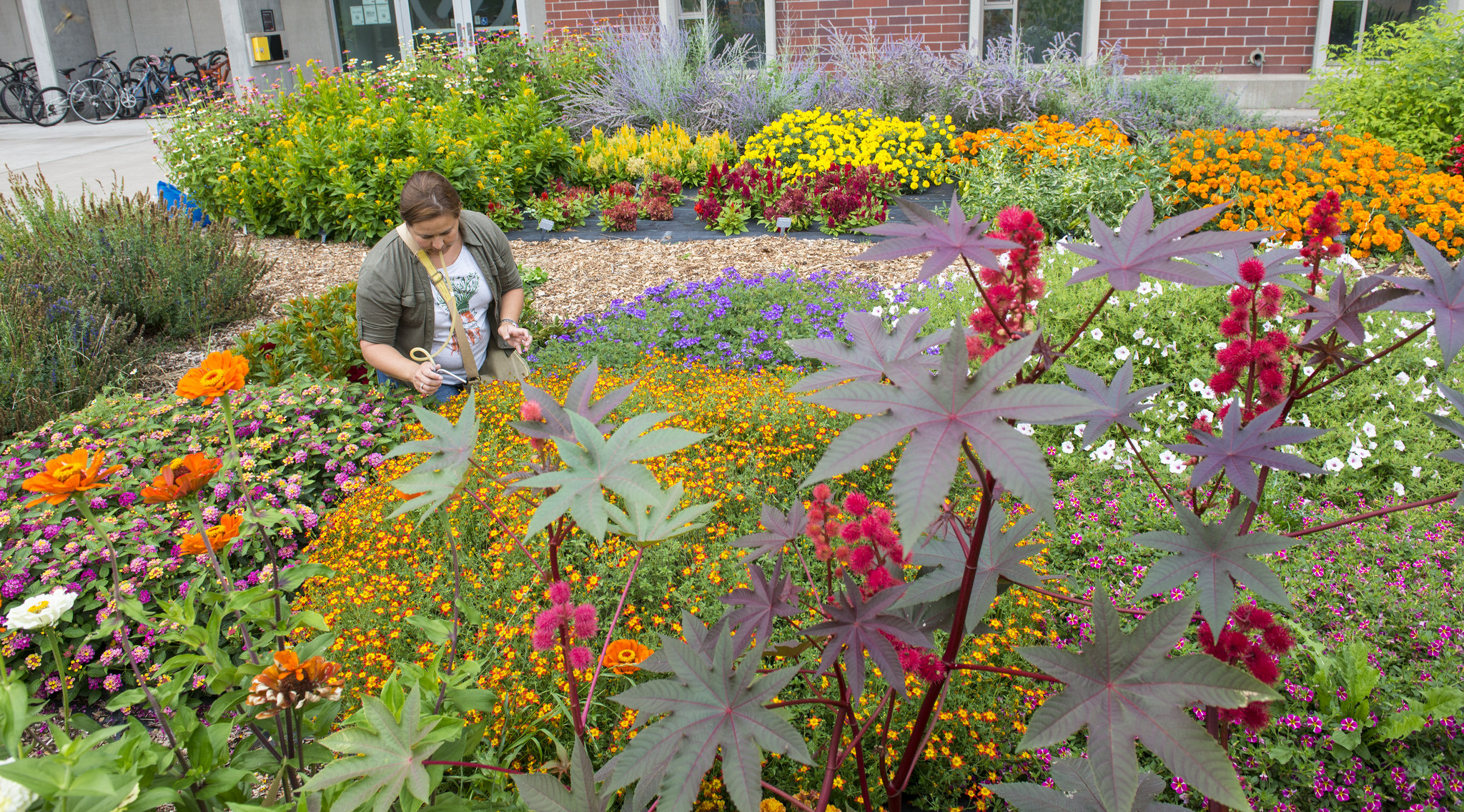
Kris LaMar and Barb Cary live at opposite ends of the state and have never met, but they’ve got a lot in common. Both women are up to their trowels as Master Gardeners.
A shade under 3,000 Oregonians join the two women who went through the intensive two- to three-month course that covers everything from soils to disease diagnosis. In return, they agreed to volunteer to advise gardeners and potential gardeners with the research-based information they learned in class. The program — part of Oregon State University Extension Service — reached 106,000 people in 2016.
“Becoming a Master Gardener is a fantastic way to increase your knowledge of sustainable gardening, to meet like-minded gardeners and to give back to your community,” said Gail Langellotto, statewide coordinator of Oregon State University Extension Service’s Master Gardener program. “People are excited about growing their own food and gardening for wildlife. Master Gardeners help people understand how to meet their goals in a way that protects and conserves natural resources.”
LaMar, who has been a Master Gardener for five years, knew nothing about the program until she saw something about it in the newspaper. At the same time she was qualifying to be a Master Recycler. Once she got her hands into compost and saw the overlap, she was hooked. She took both courses and has become one of the most active Master Gardener volunteers, teaching classes, monitoring the Clackamas County speakers bureau and, most of all, answering hundreds of questions – 2,200 since she started a little over a year ago – in Ask an Expert, an online question and answer service through Extension.
“I can stay home in my jammies,” she said. “I don’t have to drive. I can answer questions from all over the world. It’s wonderful because I get to learn all this, too. Like an insect that lives in Mozambique or India or Norway. I’ve found my niche. I can’t think of a better way to spend my time.”
LaMar makes a good point. Master Gardeners don’t stop learning after finishing the course. When they can’t immediately diagnose and solve a problem, they turn to the wealth of research from OSU, other universities and reputable sources.
The breadth of activities Master Gardeners do for volunteer hours is wide. Some answer questions via email or phone hotlines, Langellotto said. Others spend time teaching in learning gardens, community gardens, even correctional institutions. Cary, a Master Gardener since 2013, works in a preschool that’s next door to a food bank where she volunteered. “They jumped on it,” she said.
For an hour a week for 18 weeks, Cary spends time with 3 and 4 year olds, reading books, germinating seeds, planting, watering and harvesting. A tomato taste test is always a winner.
“It’s fun, so fun,” she said. “The little kids are really engaged and we get positive feedback from the parents. We use it as a carrot for good behavior and it works.”
You don’t have to be an experienced gardener to sign up for the classes. In fact, many people join to learn more about their own garden. LaMar, who was a judge in Portland for 25 years, grew houseplants and container plants. Cary was too busy during her career days to garden, but once she retired and moved from Orange County, California, to Brookings she got busy. Both said being a Master Gardener has helped enormously.
While Cary took the class in person, LaMar took the online course – a new option – and recommends it to people who can’t make it to classes.
“Master Gardeners tend to be retired,” she said. “I’d like to see more young people get involved and the online course offers that flexibility.”
The in-person course, which is given in most counties, commits participants to 40 to 70 volunteer hours after completing the series. Call your local Extension office to see if one is offered near you. Each county has a different price scale and schedule. Registration is taking place now in most areas for classes held this winter. The online class can be taken any time.
For more information, see Extension’s publication An Introduction to Becoming a Master Gardner Volunteer and an additional brochure.
——–

Tips for gardening with children from Barb Cary
- Keep concepts simple and age appropriate: Explain terms like “germination” and “pollination” in words that 3 to 4 years olds will understand. There are many picture/preschool books that support these topics.
- Use kid-sized tools, raised beds, and watering cans.
- Let kids choose the vegetables that are grown as much as possible. Start some plants from seeds and some from starts. Choose seeds that are large and easy for small fingers to handle like peas and green beans.
- Vary topics to include all aspects of gardening: study earthworms and release them into the raised beds; study ladybugs (good vs. bad insects) and do a ladybug release; release a monarch butterfly in a segment on butterflies and caterpillars.
- Encourage kids to try vegetables. This year, one of our boys didn’t like raisins. I asked if he liked grapes. I did. I then explained that raisins were just dried out grapes.
- Same for tomatoes. If kids like pizza or spaghetti, then they are eating tomatoes, too. We do taste comparisons of tomatoes: cherry vs. heirloom vs. different colors. They loved a “stop light” assessment of red, green and yellow bell peppers.
- Always grow strawberries!
Five commonly asked questions from Ask an Expert provided by Kris LaMar
Q: What are some of the best native plants to attract pollinators?
A: Some good choices include milkweed (Monarch butterflies and hummingbirds); salal (bees and butterflies); serviceberry (also called amalanchier) (bees, butterflies and hummingbirds); oceanspray (bees and butterflies); and hairy manzanita (bees, hummingbirds and beneficial insects.) Fall is a good time to plant and transplant perennial plants. Native Plants for Willamette Valley Yards is a good source for more information.
Q: Is there anything to treat black spot on my rose bush leaves?
A: First, don’t leave leaves on the ground near rose plants, which keeps the fungus that infects leaves in the spring near your roses. Monitor your rose bushes in the spring, when fungal spores are in the air, and look for gray spots on the undersides of the leaves. Treat with a fungicide, such as Neem oil, spraying it directly on the fungus.
Q: Why do my cucumbers and other squash get a gray coating on them?
A: Once the rains of spring stop, and it get drier and warmer, another airborne fungus settles and grows on plant leaves. While it may not kill the plant, it is unsightly and can weaken the plant. Treat with a fungicide, such as Neem oil, consistently throughout the summer and early fall.
Q: Why are my azalea plant’s leaves turning yellow?
A: The azalea lace bug is an insect whose eggs are laid on the undersides of the leaves, and the growing bug sucks out the chlorophyll from the leaf, so it can no longer photosynthesize. Eventually, the leaf turns yellow and may die and fall off. We do not yet have sufficient insects that can control the azalea lace bug, and they may have four generations each growing season. If possible, spray an insecticide such as Neem oil, on the underside of the leaves.
Q: How can I help the soil in my garden over the winter?
A: First, add organic material, such as leaves, compost (without weed seeds or diseased plants), and leaves and roots of plants you didn’t eat. Second, plant a cover crop, such as red crimson clover or fava beans, covered with straw. The plants will help restore available nitrogen to your plants in the spring. Fava beans are edible, and the foliage and straw will help protect the soil from being compacted by rain. (Just be sure to cut off clover flowers before they go to seed, or gently turn the plants under, so your spring garden isn’t filled with clover.)

